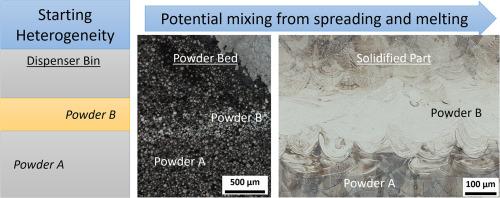Understanding the effects of metal powder feedstock heterogeneity on the laser powder bed fusion process
IF 2.9
Q2 MATERIALS SCIENCE, MULTIDISCIPLINARY
引用次数: 0
Abstract
Powder reuse is important to reduce the cost and improve the sustainability of laser powder bed fusion (PBF-LB) additive manufacturing. Several powder reuse strategies involve the blending of unused feedstock powder with used powder, which assume that the bulk properties of blends are sufficient knowledge for decision making. Here we consider how potential chemical heterogeneity within a blend may occur locally in the dispenser (e.g., a relatively high fraction of one component of the blend compared to the expected ratio). This becomes particularly important when the usage histories of the constituent powders in the blend have significant differences. A set of experiments was designed to introduce controlled heterogeneities in the dispenser and assess the effects on the spreading process and printed parts. Specific layer-wise heterogeneities were created by switching back and forth between powder feedstocks (IN718 and CoCrMo) during a build, as an analogous but more easily measurable situation compared to mixing and tracking reused powders of the same alloy. The Co concentration was spatially mapped parallel to the build height for lightly sintered powder capture capsules and solidified parts to determine how these heterogeneities manifest in the process before and after laser melting. The melting process in PBF-LB was determined to cause significant elemental redistribution as opposed to the initial powder spreading process, which had little contribution. In every case, the starting inhomogeneity diluted in intensity but increased in spatial size to more than twice the programmed layer thickness.

了解金属粉末原料不均匀性对激光粉末床熔合过程的影响
粉末再利用对于降低成本和提高激光粉末床熔融(PBF-LB)增材制造的可持续性至关重要。几种粉末再利用策略涉及将未使用的原料粉末与已使用的粉末混合,这假设混合物的体积特性足以用于决策。在这里,我们考虑混合物中潜在的化学不均匀性如何可能在分配器局部发生(例如,与预期比例相比,混合物的一种组分的相对较高的分数)。当混合物中组成粉末的使用历史有显著差异时,这变得特别重要。设计了一组实验,以引入受控的非均匀性,并评估其对涂胶过程和打印部件的影响。在构建过程中,通过在粉末原料(IN718和CoCrMo)之间来回切换,可以产生特定的分层不均匀性,与混合和跟踪相同合金的重复使用粉末相比,这是一种类似但更容易测量的情况。对轻烧结粉末捕获胶囊和固化部件的Co浓度进行平行于构建高度的空间映射,以确定这些非均质性在激光熔化前后的过程中如何表现。在PBF-LB中,与初始粉末扩散过程相比,熔化过程产生了显著的元素重分布,而初始粉末扩散过程的贡献很小。在每一种情况下,开始的不均匀性在强度上被稀释,但在空间尺寸上增加到程序层厚度的两倍以上。
本文章由计算机程序翻译,如有差异,请以英文原文为准。
求助全文
约1分钟内获得全文
求助全文
来源期刊

Materialia
MATERIALS SCIENCE, MULTIDISCIPLINARY-
CiteScore
6.40
自引率
2.90%
发文量
345
审稿时长
36 days
期刊介绍:
Materialia is a multidisciplinary journal of materials science and engineering that publishes original peer-reviewed research articles. Articles in Materialia advance the understanding of the relationship between processing, structure, property, and function of materials.
Materialia publishes full-length research articles, review articles, and letters (short communications). In addition to receiving direct submissions, Materialia also accepts transfers from Acta Materialia, Inc. partner journals. Materialia offers authors the choice to publish on an open access model (with author fee), or on a subscription model (with no author fee).
 求助内容:
求助内容: 应助结果提醒方式:
应助结果提醒方式:


